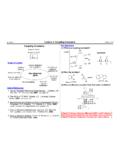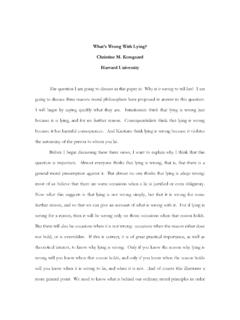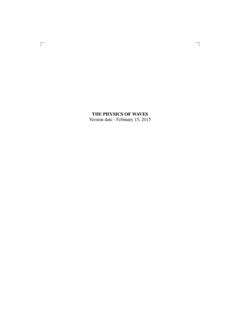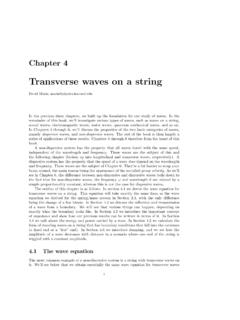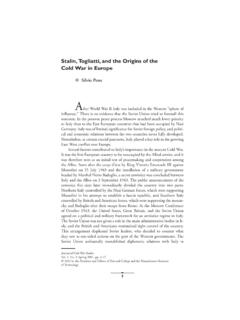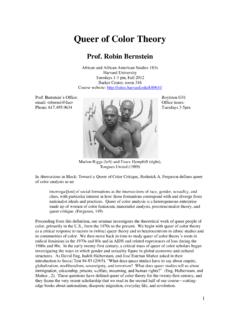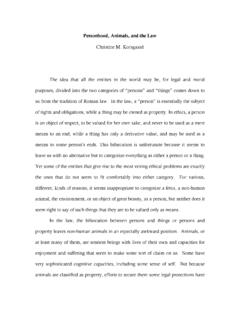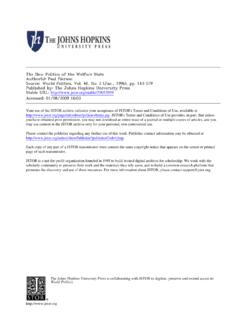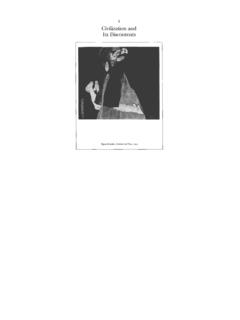Transcription of Introduction to quantum mechanics - Harvard University
1 Chapter 10 Introduction to quantummechanicsDavid Morin, chapter gives a brief Introduction to quantum mechanics . quantum mechanics can bethought of roughly as the study of physics on very small length scales, although there arealso certain macroscopic systems it directly applies to. The descriptor quantum arisesbecause in contrast with classical mechanics , certain quantities take on only discrete , some quantities still take on continuous values, as we ll quantum mechanics , particles have wavelike properties, and a particular wave equa-tion, theSchrodinger equation, governs how these waves behave. The Schrodinger equationis different in a few ways from the other wave equations we ve seen in this book. But thesedifferences won t keep us from applying all of our usual strategies for solving a wave equationand dealing with the resulting some respect, quantum mechanics is just another example of a system governed by awave equation. In fact, we will find below that some quantum mechanical systems haveexactanalogies to systems we ve already studied in this book.
2 So the results can be carried over,with no modifications whatsoever needed. However, although it is fairly straightforwardto deal with the actual waves, there are many things about quantum mechanics that are acombination of subtle, perplexing, and bizarre. To name a few: the measurement problem,hidden variables along with Bell s theorem, and wave-particle duality. You ll learn all aboutthese in an actual course on quantum though there are many things that are highly confusing about quantum mechanics ,the nice thing is that it s relatively easy to apply quantum mechanics to a physical systemto figure out how it behaves. There is fortunately no need to understand all of the subtletiesabout quantum mechanics in order to use it. Of course, in most cases this isn t the beststrategy to take; it s usually not a good idea to blindly forge ahead with something if youdon t understand what you re actually working with. But this lack of understanding canbe forgiven in the case of quantum mechanics , because no one really understands it.
3 (Well,maybe a couple people do, but they re few and far between.) If the world waited to usequantum mechanics until it understood it, then we d be stuck back in the 1920 s. Thebottom line is that quantum mechanics can be used to make predictions that are consistentwith experiment. It hasn t failed us yet. So it would be foolish not to use main purpose of this chapter is to demonstrate how similar certain results in quan-tum mechanics are to earlier results we ve derived in the book. You actually know a good12 CHAPTER 10. Introduction TO quantum mechanics deal of quantum mechanics already, whether you realize it or outline of this chapter is as follows. In Section we give a brief history of thedevelopment of quantum mechanics . In Section we write down, after some motivation,theSchrodinger wave equation, both the time-dependent and time-independent forms. InSection we discuss a number of examples. The most important thing to take away fromthis section is that all of the examples we discuss haveexactanalogies in the string/springsystems earlier in the book.
4 So we technically won t have to solve anything new here. Allthe work has been done before. The only thing new that we ll have to do is interpret the oldresults. In Section we discuss theuncertainty principle. As in Section , we ll findthat we already did the necessary work earlier in the book. The uncertainty principle turnsout to be a direct consequence of a result from Fourier analysis. But the interpretation ofthis result as an uncertainty principle has profound implications in quantum A brief historyBefore discussing the Schrodinger wave equation, let s take a brief (and by no means com-prehensive) look at the historical timeline of how quantum mechanics came about. Theactual history is of course never as clean as an outline like this suggests, but we can at leastget a general idea of how things (Planck):Max Planck proposed that light with frequency is emitted in quantizedlumps of energy that come in integral multiples of the quantity,E=h = h (1)whereh 10 34J s isPlanck s constant, and h h/2 = 10 34J frequency of light is generally very large (on the order of 1015s 1for the visiblespectrum), but the smallness ofhwins out, so theh unit of energy is very small (at least onan everyday energy scale).
5 The energy is therefore essentially continuous for most , a puzzle in late 19th-century physics was theblackbody radiationproblem. In anutshell, the issue was that the classical (continuous) theory of light predicted that certainobjects would radiate an infinite amount of energy, which of course can t be correct. Planck shypothesis of quantized radiation not only got rid of the problem of the infinity, but alsocorrectly predicted the shape of the power curve as a function of results that we derived for electromagnetic waves in Chapter 8 are still true. Inparticular, the energy flux is given by the Poynting vector in Eq. AndE=pcfora light. Planck s hypothesis simply adds the information of how many lumps of energy awave contains. Although strictly speaking, Planck initially thought that the quantizationwas only a function of the emission process and not inherent to the light (Einstein):Albert Einstein stated that the quantization was in fact inherent to thelight, and that the lumps can be interpreted as particles, which we now call photons.
6 Thisproposal was a result of his work on thephotoelectric effect, which deals with the absorptionof light and the emission of elections from a know from Chapter 8 thatE=pcfor a light wave. (This relation also follows fromEinstein s 1905 work on relativity, where he showed thatE=pcfor any massless particle,an example of which is a photon.) And we also know that =ckfor a light wave. SoPlanck sE= h relation becomesE= h = pc= h(ck) = p= hk(2)This result relates the momentum of a photon to the wavenumber of the wave it is A BRIEF HISTORY31913 (Bohr):Niels Bohr stated that electrons in atoms have wavelike properties. Thiscorrectly explained a few things about hydrogen, in particular the quantized energy levelsthat were (de Broglie):Louis de Broglie proposed thatallparticles are associated with waves,where the frequency and wavenumber of the wave are given by the same relations we foundabove for photons, namelyE= h andp= hk. The largerEandpare, the larger andkare. Even for smallEandpthat are typical of a photon, andkare very largebecause his so small.
7 So any everyday-sized particle with large (in comparison) energy andmomentum values will have extremely large andkvalues. This (among other reasons)makes it virtually impossible to observe the wave nature of macroscopic amounts of proposal (thatE= h andp= hkalso hold for massive particles) was a big step,because many things that are true for photons arenottrue for massive (and nonrelativistic)particles. For example,E=pc(and hence =ck) holds only for massless particles (we llsee below how andkare related for massive particles). But the proposal was a reasonableone to try. And it turned out to be correct, in view of the fact that the resulting predictionsagree with fact that any particle has a wave associated with it leads to the so-calledwave-particle duality. Are things particles, or waves, or both? Well, it depends what you re doingwith them. Sometimes things behave like waves, sometimes they behave like particles. Avaguely true statement is that things behave like waves until a measurement takes place,at which point they behave like particles.
8 However, approximately one million things areleft unaddressed in that sentence. The wave-particle duality is one of the things that fewpeople, if any, understand about quantum (Heisenberg):Werner Heisenberg formulated a version of quantum mechanics thatmade use ofmatrix mechanics . We won t deal with this matrix formulation (it s ratherdifficult), but instead with the following wave formulation due to Schrodinger (this is awaves book, after all).1926 (Schrodinger):Erwin Schrodinger formulated a version of quantum mechanics thatwas based on waves. He wrote down a wave equation (the so-calledSchrodinger equation)that governs how the waves evolve in space and time. We ll deal with this equation in depthbelow. Even though the equation is correct, the correct interpretation of what the waveactually meant was still missing. Initially Schrodinger thought (incorrectly) that the waverepresented the charge (Born):Max Born correctly interpreted Schrodinger s wave as a probability am-plitude.
9 By amplitude we mean that the wave must be squared to obtain the desiredprobability. More precisely, since the wave (as we ll see) is in general complex, we need tosquare its absolute value. This yields the probability of finding a particle at a given location(assuming that the wave is written as a function ofx).This probability isn t a consequence of ignorance, as is the case with virtually everyother example of probability you re familiar with. For example, in a coin toss, if youknow everything about the initial motion of the coin (velocity, angular velocity), alongwith all external influences (air currents, nature of the floor it lands on, etc.), then youcan predict which side will land facing up. quantum mechanical probabilities aren t likethis. They aren t a consequence of missing information. The probabilities aretrulyrandom,and there is no further information (so-called hidden variables ) that will make things un-random. The topic of hidden variables includes various theorems (such as Bell s theorem)and experimental results that you will learn about in a quantum mechanics 10.
10 Introduction TO quantum MECHANICS1926 (Dirac):Paul Dirac showed that Heisenberg s and Schrodinger s versions of quantummechanics were equivalent, in that they could both be derived from a more general versionof quantum The Schrodinger equationIn this section we ll give a derivation of the Schrodinger equation. Our starting point willbe the classical nonrelativistic expression for the energy of a particle, which is the sum ofthe kinetic and potential energies. We ll assume as usual that the potential is a function ofonlyx. We haveE=K+V=12mv2+V(x) =p22m+V(x).(3)We ll now invoke de Broglie s claim that all particles can be represented as waves withfrequency and wavenumberk, and thatE= h andp= hk. This turns the expressionfor the energy into h = h2k22m+V(x).(4)A wave with frequency and wavenumberkcan be written as usual as (x, t) =Aei(kx t)(the convention is to put a minus sign in front of the t). In 3-D we would have (r, t) =Aei(k r t), but let s just deal with 1-D. We now note that t= i = =i t,and 2 x2= k2 = k2 = 2 x2.

